

Alec Nicol - NanoJapan 2012
University of Minnesota, Twin Cities
Major/s: Chemistry & Biochemistry
Anticipated Graduation: May 2014
NJ Research Lab: Prof. Yuichi Ochiai & Noboyuki Aoki, Chiba University
NJ Research Project: Room-temperature Graphene THz Detectors
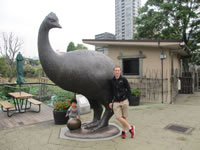
Meaning of NanoJapan
After my first year of college classes I knew that I had a particular attraction towards chemistry. The logical framework that a compounds structure determines its properties, which in turn determines how it will react in a larger mechanism proved itself to me as something so elegant that it invoked a deep passion inside of me to learn more. For me, nanotechnology is the epitome of what I love about science. My research involving nanoparticle drug delivery at the University of Minnesota has made me realize that nanoscience depends on an interdisciplinary approach that considers aspects of chemistry, biology, materials science, and physics. Consequently, large scale collaborations are often common practice. I selected the NanoJapan program because I wanted to refine my research skills by partaking in collaborative research on a side of the spectrum that I am not use to. I think that being put out of my comfort zone will allow me to develop realistic expectations and ideologies that will allow me to be a more effective collaborator in the future. I feel that the NanoJapan program is important to physics and engineering students nationwide because it fosters globally-competent scientists. As far as research goes, I am looking forward to learning about nanotechnology topics that I have not had exposure to yet. Aesthetically, I am excited to travel the country and do some hiking.
Overall, I think that Japan offers the ideal platform for continuing to learn about nanoscience while also experiencing the differences and similarities that transnational research imposes. Although this will be my first experience in Japan, I am excited for this opportunity and believe that this will be a period of unparalleled intellectual and cultural growth.
My goals for this summer were to:
Research Project Overview: Room-temperature Graphene THz Detectors
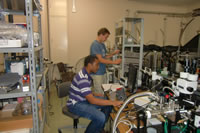 This summer I worked on developing a broadly tunable graphene field effect transistor (GR-FET) sensor for application in the microwave (GHz) to terahertz (THz) regimes. Existing GR-FETs have been fabricated by micromechanical exfoliation of highly oriented pyrolytic graphite contacted with submicron-scale metal electrodes (Ti/Au or Pd/Au). The microwave transconductance characteristics show excellent photoresponse around the X band (~10 GHz) and are predicted to have continued sensitivity in the THz range after the measurement setup is optimized. This summer I made improvements to the wiring setup, sample box architecture, graphite source, and bolometric heating of the GR-FET sensor in order to extend microwave photoresponse to 40 GHz and further improve THz detection.
This summer I worked on developing a broadly tunable graphene field effect transistor (GR-FET) sensor for application in the microwave (GHz) to terahertz (THz) regimes. Existing GR-FETs have been fabricated by micromechanical exfoliation of highly oriented pyrolytic graphite contacted with submicron-scale metal electrodes (Ti/Au or Pd/Au). The microwave transconductance characteristics show excellent photoresponse around the X band (~10 GHz) and are predicted to have continued sensitivity in the THz range after the measurement setup is optimized. This summer I made improvements to the wiring setup, sample box architecture, graphite source, and bolometric heating of the GR-FET sensor in order to extend microwave photoresponse to 40 GHz and further improve THz detection.
The knowledge I have gained involving graphene this summer will be applicable to my ongoing research at the University of Minnesota where I am incorporating graphene into mesoporous silica nanoparticles for dual drug delivery and photothermal treatment against cancer cells. Additionally, I feel that I have enhanced my ability to operate in a cross-cultural and unfamiliar environment. I think this is an important skill to have because research is an international phenomenon and the ability to coordinate trans-national efforts as efficiently as possible is huge advantage in that respect. My experience this summer has undoubtedly enhanced my drive to attend graduate school or MD/PhD.
The Ochiai/Aoki lab will do a great job of taking care of you and welcoming you into their “family”. In a lot of ways they do become your family because, like most Japanese labs, everyone works long hours and often time’s weekends. Everyone in the lab is super nice although they can be shy at times. You often times have to initiate conversations. They are all very laid back and were always willing to help me with my experiments. Most students are working towards their masters, but also have a second job. Besides going out to eat, I also went to a Chiba Marines baseball game and a 3-day research conference in Nagoya with my graduate student advisor.
Daily Life in Japan
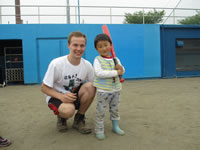 I quickly realized that Japanese labs work later hours and that this fact was not going to change on my behalf. Therefore, I used the mornings to explore Chiba. My favorite place to go was Inage Beach. I would bike there in the morning, run along the beach, go for a quick swim in Tokyo Bay, dry off in the sun, and bike back to my apartment to shower off. I would usually get into lab at 10:30am and solidly work until 9pm or later. My advisor and I made a detailed schedule for the summer so I always had experiments to do. I finished most of my research project before the mid-program meeting. After the meeting I worked on writing 2 journal manuscripts and made sure that the results I got were repeatable. I usually brought leftovers from dinner to eat for lunch. I cooked most of my own food during the weekdays. About halfway through the internship I discovered the Chiba University Recreation Center. I started to go there after work to weight lift, boulder/rock climb, and practice ping-pong.
I quickly realized that Japanese labs work later hours and that this fact was not going to change on my behalf. Therefore, I used the mornings to explore Chiba. My favorite place to go was Inage Beach. I would bike there in the morning, run along the beach, go for a quick swim in Tokyo Bay, dry off in the sun, and bike back to my apartment to shower off. I would usually get into lab at 10:30am and solidly work until 9pm or later. My advisor and I made a detailed schedule for the summer so I always had experiments to do. I finished most of my research project before the mid-program meeting. After the meeting I worked on writing 2 journal manuscripts and made sure that the results I got were repeatable. I usually brought leftovers from dinner to eat for lunch. I cooked most of my own food during the weekdays. About halfway through the internship I discovered the Chiba University Recreation Center. I started to go there after work to weight lift, boulder/rock climb, and practice ping-pong.
I always traveled on the weekends. I usually would go to Tokyo and stay with a fellow NanoJapaner. I used the last day on my JR East pass to visit Yamagata to visit a friend. I took a few overnight camping trips to Tomiura (Southern Chiba) and Choshi (Eastern Chiba). Great beach towns! I took a week off before the mid-program meeting to visit Osaka, Nara, Amonohashidate, Kinosaki Onsen, Nagashima Spaland Theme Park, Hiroshima, Miyajima, Kobe, and Rokko Island. I also attended the three-day International Symposium on Carbon Nanotube Nanoelectronics (CNTNE 2012) conference in Nagoya with a few labmates.
My favorite experiences in Japan were…
Going to Miyajima and hiking Mt. Misen. The trail we took up the mountain followed a beautiful cascading stream. Visiting Minami-Sanriku and running through abandoned JR train tunnels and Tachiwo fishing with my research advisor in Tokyo Bay.

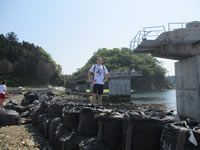
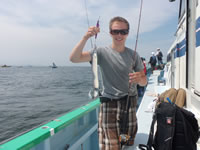
Before I left for Japan I wish I had …
Watched fewer YouTube videos on daily life in Japan. I think it took away some shock value from my first few days in Japan.
While I was in Japan I wish I had …
Gone to the Izu Islands. I had to cancel my trip due to poor weather.
Pre-Departure Tips
Try to make a bucket list of things you want to do in Japan before you leave. It was really interesting to look back on my list to see how things changed and evolved. Read a book about Japanese history prior to departure. Print around 5 good research papers to read on the plane.
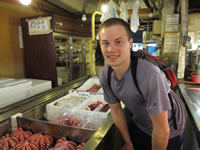 Orientation Program Tips
Orientation Program Tips
Get up early every day and go running! The Sanuki Club hotel is in a fantastic location right in the heart of Tokyo. The first day everyone should run to Tsuiji Fish Market. Don’t bring a camera and keep walking or else the police will know you are a tourist and they will ask you to leave. Go out during the evenings - sleep can wait until you get back to the USA! Try to contact your lab during this time to get a better picture of what your research project will be and start reading papers.
Mid-Program Meeting Tips
Use your JR Pass to travel before and after the meeting. It is impossible to see all of Kyoto in 3 days. Research and prioritize what you want to see. Try to have meaningful research results at this point because you will need to give a presentation.
Tips on Working in a Japanese Lab
Keep a detailed lab notebook. I treated mine almost like a diary but it helped me to stay organized and creative. Talk to your advising professor as much as possible. Bring up new ideas you have about your project. Ask them about their hobbies and education. They will probably end up writing you a letter of recommendation later on so it is important to show that you are enthusiastic and knowledgeable. As far as research goes, I was in a different situation than most people. My graduate student advisor was from Sudan. His English was excellent so I really did not have the communication problems that most people had. Give short research updates at your lab group meetings. Everyone usually gets to lab around 11am and stays till 9pm, so use your mornings to go explore Chiba.
Tips on Working in a Japanese Lab
Chiba is essentially a sprawling Tokyo suburb but has a few nice features, namely Inage Beach and the fact that everything is significantly less expensive than in Tokyo. Your standard of living and housing situation will be a lot nicer than most NanoJapaners. You can get to most places in Chiba by bike. A few favorite things I did in Chiba were: attend a Chiba Marines baseball game, tour the JFE steel mill, tachiwo fishing in Tokyo Bay, Campa Sushi (rotating sushi bar), Inage Shrine, Tokyo Disney Sea, and sneak into a Costco for pizza. There will probably be NanoJapaners researching at the University of Tokyo, so go to Tokyo during the weekends and stay with them. Explore the southern part of Chiba Prefecture (minami boso) because there are some really nice beaches and camping there. I went to Iwai and Tomiura. Choshi is also very nice and some really interesting white sand cliffs and a lighthouse. If you overlook the Pacific from the top of the lighthouse, you can clearly see the curvature of the earth.
Language Study Tips
Memorize the hiragana and katakana before you leave in addition to a few basic survival phrases. The language classes during the three week orientation are very intense and move at a fast pace. Do your homework and stay engaged by practicing Japanese at restaurants and in public places. Take advantage of language classes at your research institution or find a labmate who is willing to help you learn.
What Gifts to Bring
I brought around 30 king size candy bars (nut goodies and nut rolls, made in my hometown of St. Paul) to give to my labmates on the first day. Beef jerky is also a great gift. I gave my professor a fancy box of chocolates. If you have any specific hobbies like fishing, bring gifts that go along with that theme. I brought a Muskie lure as a gift and it just so happened that my research advisor loved to fish. He liked the gift so much that he took me on a fishing trip to Tokyo Bay.
What to Eat
Be adventurous and try to not order the same thing twice. I cooked a lot during the research internship. If you’re trying to eat cheap, buy yourself a big 5kg bag of rice early on and munch on that for the next month. Try to find local vegetable stands because they are a lot cheaper than grocery stores or even Lawson’s 100. French toast is probably the cheapest and most delicious thing you can make in Japan (use honey as a substitute for maple syrup). Buy some tupperware early on so you can bring dinner leftovers to lunch the next day. My strategy was to eat cheap during the work week and splurge on the weekends.
What to Do in Japan
Follow your passions. I like the ocean, hiking, and camping so I naturally gravitated towards activities involving these. Try to do things in small groups (2-4 people). You are in Japan for a very short time so never pass down the opportunity to try something new.
Places to Visit in Japan
Purchase a JR Pass and use it as much as you can! I got a 7 day pass and used it to its fullest extent. I was literally crashing at the end from lack of sleep and stress, but it was all worth it. Try to take a week off of lab before or after the mid-program meeting and do all of your traveling then. I took the week off before the Mid-Program Meeting and stayed in Kyoto with a fellow NanoJapaner. I took day trips to Osaka, Nara, Amonohashidate, Nagashima Spaland (theme park outside of Nagoya), Hiroshima/Miyajima, and Kobe. During the 3-week orientation period you will get a chance to meet with Japanese college students. Try to make friends with them and make plans to visit. I met up with a student that went to Tohoku University and he showed me his hometown of Yamagata. He had a car so I got to visit places I would have never had the chance to go otherwise. If you go to Yamagata in early June you can enjoy fresh cherries and pears. I traveled to Tokyo quite often on the weekends since I was in Chiba. Southern Chiba is really beautiful and has some spectacular beaches and hiking. Try to travel with a buddy, preferably one that speaks Japanese.
Photos and Excerpts from Weekly Reports
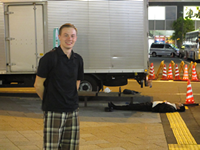
Week One - Arrival in Japan: This is my first time living in a downtown area for an extended period of time and I really like the fact that you can walk to so many restaurants and food markets. It is really easy to feel a sense of community in this way. I am jogging every morning with a group of NJ students and I feel that I am really starting to know the area near the Azabu-Juban neighborhood. Photo: Only in Akihabara: I guess the fact that he had time to take his shoes off means he is okay, right?
Week Two - Riding the Subway: Most people ride by themselves and it is not common for random people to
start talking to each other. Random conversations are common on city
buses in St. Paul. NJ participants often ride in groups and talk on the
subway. I have not been told to be quiet so I think that talking is
generally acceptable if you are reasonably quiet. There is always
someone sleeping on the subway no matter what time of day and no matter
how short the ride. Lots of people read on the subway or just sit there
and space out. Texting is also very common on the subway. Public
displays of affection are a rarity on the subway. Even if a guy is
sitting with his girlfriend, they commonly refrain from holding hands or
talking. At least on the lines that I have commonly traveled, there are
very few children that ride the subway. Most riders include working
businessman and teens.
I feel that the Tokyo subway system is a lot more efficient than most US
systems. You really don’t need to know any Japanese to use it and there
are many signs to help you figure out which line to take. The Suica
Pass is really a great thing to have and saves you a lot of time. Some
NJ people are holding out from buying it, but it really does not make
sense to not have one.
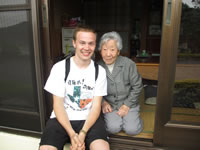 Week 3 - Trip to Minami-Sanriku: During our last day (Sunday morning) Eric, a KIP student and myself went
running with me up some river valley north of Minami-Sanriku. We passed
by this rather large debris pile and came to a small concrete bridge
that crossed a stream. We quickly noticed that someone had gathered
several large family photo albums from the wreckage and placed them in a
box by the bridge. The photos were severely water damaged and had sand
crusted between the pages. However, it was still possible to see faint
images of family members. There were a few other items in the box
including some birthday/holiday cards and a “Kill Bill DVD”. Most
shocking was a scroll that the KIP member identified as being a high
school diploma from the 80s. This moment really touched my heart. I
can’t even imagine how it would feel to lose such personal items; items
that define your family’s history and your accomplishments in life. It
really made me think on the run back, when looking at the giant piles of
rubble that each scrap of debris was part of someone’s life.
Week 3 - Trip to Minami-Sanriku: During our last day (Sunday morning) Eric, a KIP student and myself went
running with me up some river valley north of Minami-Sanriku. We passed
by this rather large debris pile and came to a small concrete bridge
that crossed a stream. We quickly noticed that someone had gathered
several large family photo albums from the wreckage and placed them in a
box by the bridge. The photos were severely water damaged and had sand
crusted between the pages. However, it was still possible to see faint
images of family members. There were a few other items in the box
including some birthday/holiday cards and a “Kill Bill DVD”. Most
shocking was a scroll that the KIP member identified as being a high
school diploma from the 80s. This moment really touched my heart. I
can’t even imagine how it would feel to lose such personal items; items
that define your family’s history and your accomplishments in life. It
really made me think on the run back, when looking at the giant piles of
rubble that each scrap of debris was part of someone’s life.
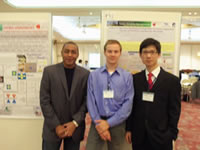 Week 4 - First Week in Research Lab: The Ochiai-Aoki lab has an interesting structure. There are about 16
graduate students (only 3 are females). Ochiai-sensei is getting older
and is starting to retire. Aoki-sensei is the professor who will take
over the lab when Ochiai-sensei leaves. They are both interesting people
with very different characteristics. Ochiai-sensei advises the graphene
group and I have meet with him every day this week. I work with a
second year PhD student named Akram. He was born in Tokyo but his family
is from Sudan. He completed his undergraduate degree in the UAE and
went on to complete his masters at Chiba University. He speaks English
and Arabic very well. He is working on improving is Japanese but can
hold a scientific conversation. He is a great communicator (we often
speak in English) and is eager to spend time with me and discuss both
life and research. When he is busy, I have the chance to work with other
Japanese students in the graphene group. Communication is always harder
with native Japanese students, but very manageable. I feel that my lab
is very friendly and accepting.
The first day was very productive but mainly focused on completing
administrative tasks. Akram and Gi (Arens grad student) were nice enough
to go with us to rent bikes for the summer, acquire parking contracts,
register with Chiba University, and introduce us to the lab
members/environment. I have already started researching and I like the
tempo.
Week 4 - First Week in Research Lab: The Ochiai-Aoki lab has an interesting structure. There are about 16
graduate students (only 3 are females). Ochiai-sensei is getting older
and is starting to retire. Aoki-sensei is the professor who will take
over the lab when Ochiai-sensei leaves. They are both interesting people
with very different characteristics. Ochiai-sensei advises the graphene
group and I have meet with him every day this week. I work with a
second year PhD student named Akram. He was born in Tokyo but his family
is from Sudan. He completed his undergraduate degree in the UAE and
went on to complete his masters at Chiba University. He speaks English
and Arabic very well. He is working on improving is Japanese but can
hold a scientific conversation. He is a great communicator (we often
speak in English) and is eager to spend time with me and discuss both
life and research. When he is busy, I have the chance to work with other
Japanese students in the graphene group. Communication is always harder
with native Japanese students, but very manageable. I feel that my lab
is very friendly and accepting.
The first day was very productive but mainly focused on completing
administrative tasks. Akram and Gi (Arens grad student) were nice enough
to go with us to rent bikes for the summer, acquire parking contracts,
register with Chiba University, and introduce us to the lab
members/environment. I have already started researching and I like the
tempo.
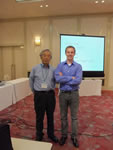 Week 5 - Attending the International Symposium on Carbon Nanotube Nanoelectronics (CNTNE 2012): The conference was a great experience and I am thankful that I had the opportunity to attend. I really enjoyed the poster session because it gave me a chance to clarify concepts and find different approaches to similar problems that I am facing in the lab. Both Ochiai-sensei and my graduate advisor gave interesting poster presentations that revealed some interesting future directions to my project that I was not aware of. The highlight of my trip was talking to Sumio Iijima after his lecture (see attached picture). I found it really interesting how he used examples of tubular structures in nature (geology and biology in particular) to help him rationalize the structure of CNTs. It just shows how important an interdisciplinary education really is. I also talked to him about the biological applications of CNT and graphene, which is an area I am interested in studying in grad/med school. He is a really inspirational person. Also, when I was introducing myself to him I brought up the fact that I was in the NanoJapan program and he shared that he had hosted NanoJapan student Jaret Lee in 2006 - the very first year of the program!
Week 5 - Attending the International Symposium on Carbon Nanotube Nanoelectronics (CNTNE 2012): The conference was a great experience and I am thankful that I had the opportunity to attend. I really enjoyed the poster session because it gave me a chance to clarify concepts and find different approaches to similar problems that I am facing in the lab. Both Ochiai-sensei and my graduate advisor gave interesting poster presentations that revealed some interesting future directions to my project that I was not aware of. The highlight of my trip was talking to Sumio Iijima after his lecture (see attached picture). I found it really interesting how he used examples of tubular structures in nature (geology and biology in particular) to help him rationalize the structure of CNTs. It just shows how important an interdisciplinary education really is. I also talked to him about the biological applications of CNT and graphene, which is an area I am interested in studying in grad/med school. He is a really inspirational person. Also, when I was introducing myself to him I brought up the fact that I was in the NanoJapan program and he shared that he had hosted NanoJapan student Jaret Lee in 2006 - the very first year of the program!
Week 6 - Research in Japan vs. the U.S.: I don’t think that researchers in Japan work longer hours than US researchers, they just work later hours. In my lab mostly everyone arrives at 8am and stays till 6pm. In Japan they work from 11am to 9pm. The same amount of hours just at a later time. I think that the typical hours worked in Japan presents many problems especially if you are married and have a family. Most of the PhD students in my lab at the U of M are female, married, and have young children. In the Ochiai lab most students are male, single, and do not have a girlfriend. Their whole life revolves around the lab. It think this is very dangerous and makes it hard to live a happy life when you are only focusing on one passion (especially if your experiments are not working). I am intrinsically a morning person so the transition is hard. Getting to lab before 10:30am is useless because nobody is there. I get to lab at 10:30am and work solidly until 8pm. However, I still wake up before 7am every morning. I use the mornings to go running/biking around Chiba. The morning’s here are cool and generally not windy. It is always interesting to see people commuting to work and school. It really makes you feel like a native. Running adds a lot of variety to each day and makes it so you are not just working for the weekend.
Week 7 - Preparing for the Mid-Program Meeting: Looking back, I am really proud of how efficiently I am using my time in Japan, both in the lab and in my spare time. There have been very few moments where I have not been doing something memorable or productive. This is a really general thing to be proud of and has led to many specific moments of accomplishment. For example, last weekend Grace and I took a camping trip to Tomiura and Iwai. Both are really remote beach/fishing towns on the southern Boso peninsula (straight south of Chiba). Tomiura was recommended to me by one of my lab mates. I did a lot of research about the city and what we were going to do there before we left. I asked my lab mates for suggestions and developed a really detailed itinerary for the trip. The trip ended up being really fun and I was proud of the way I handled planning. I found this really cool campsite that was on a peninsula that stuck out into the ocean. The view was spectacular from our campsite and you could clearly see across Tokyo bay to Kamakura, although Fuji was not visible. The entire experience has given me more confidence in planning how I will use my 7-day JR pass.
Week 8 - Reflections on Japanese Language & Culture: On Tuesday I set an ambitious plan to travel from Kyoto to Amanohashidate and Kinosaki Onsen. Both of these places are located along the Japan Sea and are really hard to get to. I planned out my route so that I was only taking a special rapid train so that I could maximize the time I was spending at each destination. I left little room for the possibility that I would miss a train. For some reason, the train from Amanohashidate to Kinosaki was 20 min late and I only budgeted an hour and a half stay in Kinosaki. I took way too much time in the onsen and forgot that I needed to grab some food before I got on the train. I got out of the onsen with 10 min to spare and frantically asked the hotel desk if there was a convenient store nearby (I used a little Japanese at this point). He said it was a 10 min walk away. I went to the train station and tried to ask if the train was on time (in English). She had no clue what I was asking and I felt like I did not have time to try to compose the question in Japanese. I tried to ask her about a convenient store (both in Japanese and English) and again she did not understand me. I was really freaking out at this point and just assumed it was going to be on time. I left my stuff at the train station and started to run to the convenient store. Once I passed the station I could clearly see a Lawsons on the other side of the tracks but I had to run probably 4 blocks before I was able to cross. I made it back to the station and had about 1 min before the train departed. Looking back, I clearly should have not gone to Lawsons to get food. I really do not know if I would have made it back that night if I missed that train. I think that if I was able to communicate better with either of the people that I asked, I would not have a problem. The confused and broken response that I got from the train attendant relative to the hotel desk worker was likely due to the rushed/frantic state I was in at the time. My hasty question and demeanor probably made the worker uneasy and less likely to understand my question. I should have approached her with a more cool and collective mindset.
Week 9 - Critical Incident Analysis in the Lab: On Wednesday I ended up going out to dinner with a few of my labemates. We went to a Ramen shop near campus and I got a soba noodle dish. This restaurant is a type where you pay a flat rate and get to choose a large or small size. I started taking to Akram (my graduate student) and pointed out how we do not have this type of ordering system in America. You buy a small, medium or large size for different costs. Akram and a few other labemates know that I am a big eater. Of course I always get the larger size. About halfway through the meal Akram pointed to a sigh in Japanese and said that if you pay Y100 more you can either get 50%, 100% or 250% more soba noodles. He was clearly messing with me because he told me after I had already ordered my food. He said the option to get 250% was “reckless”. I find this a really amazing option and would not expect to find this in Japan where food is so expensive. I really don’t get how this makes sense from a business end either. 250% more food for 100 yen will clearly result in a loss of money for the restaurant, especially if the customer would have bought 2 dishes otherwise. On a similar note, when I was in Hiroshima the group I was with went to an Okonomiaki restaurant. Suspiciously, there was an icecream cooler out on the main restaurant floor. At the end of our meal I asked the waitress how much the icecream cost. She said it was all you can eat for Y250! There were 9 flavors and they were all of excellent quality. The offer was not listed in the menu or posted anywhere around the restaurant. It seems like in Japan there are a lot of hidden offers like this. Either you have to be really inquisitive or be a regular to find out about them.
Week 10 - Career Interview: I interviewed Nobuyuki Aoki, who is an associate professor in my lab at Chiba University. Ochiai-sensei and Aoki-sensei essentially advise our lab group together. After Ochiai-sensei retires in a few years, Aoki-sensei will take over. Aoki-sensei received his PhD in materials science from JAIST (Hokuriku, Japan) in 1998. He started to work at Chiba University in 1999 as a research assistant. From 2004 to 2005 he worked at Arizona State University as a “Faculty Research Associate” which was supported by a postdoc fellowship from the JSPS. He is currently an “Associate Professor at the Graduate School of Advanced Integration Science at Chiba University. His research has consistently been on transport in nanostructures, particularly carbon nanotubes. He finds researching nanostructures very exciting because it provides a means to study very fundamental quantum mechanical phenomenon. His research is funded by a number of university, government, and private grants. He has always liked teaching people and felt a natural attraction to teach at the University level. He says that becoming a professor means that you are constantly working; advising students, writing grants, traveling to conferences, and teaching classes. Although these tasks keep him busy, he really likes the challenge and the responsibility that it requires. He says that he feels like he has built up a family at Chiba University. He says that if you would like to continue with a career in research, it is important to find a topic that you are passionate about. More often than not, research ends in failure so loving what you do is important to keep you from going insane. He also says that finding a good lab is important because often times the people in the lab will become your best friends. Each lab has a different environment and it is important to find one that suits your style.
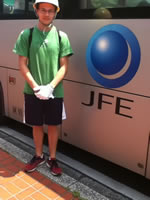 Week 11 - Final Week in Japan: Looking back, I clearly did not know a lot about Japan before coming
here. I imagined Japan to be like Obaiba with mountains and beaches
scattered around here-and-here. Now I realize that it is a very dynamic
and varied place with a very unified but distinct people (mostly based
on region-country or city, island, ect…). I really appreciate the
environment in the US a lot more and can see why it has the advantages
and problems that it does. This is an outside perspective that I would
have never gotten while continuing to live in Minnesota. My success with research this summer has only reassured me of my love for science. I already had a strong passion to go into further research as a PhD or MD/PhD student after my undergraduate career and I still hold those same views today. However, I have learned that unless you are on a fellowship, graduate study in a foreign country is really expensive. Akram was not awarded a fellowship so he is essentially paying out of pocket for his PhD education. It is really hard justifying going to another country for graduate school when the US is so strong and financially attractive. There are many international conference opportunities and international research collaborations that you can get involved with as a graduate student in the US which fulfills many of the same attributes as working as a foreign grad student would have. I think that international collaborations are important and do facilitate different approaches to the same problem for faster results. My final week was really relaxing and offered a deep sense of closure. I essentially had all of my experiments done at that point and only had to do a few frequency response replicate measurements with previously prepared samples. I spend most of the week preparing a draft of a paper that we will hopefully submit later on this summer which encompasses the majority of my work this summer. I also worked on figure/captions and editing. I had a lot of time (especially in the mornings) to go to Inage Beach and get a few things checked off my Chiba bucket-list. Most exciting of all was a JFE Steel Mill tour that I went on later in the week. I went on a steel mill tour in St. Paul before and it was the coolest thing I have seen in my life. This tour was very similar but this plant specialized in sheet metal rather than rebar. I also went to a rotating-sushi bar. Ochiai-sensei was in Dresden for my last week so I did not give him a formal goodbye (other than email). We had a going-away party on Friday and I said goodbye to everyone there. I wrote farewell notes to a few special people and gave them some leftover gifts. Akram and I had a really heart-to-heart farewell discussion. I will spend the last few days socializing with NanoJapan students.
Week 11 - Final Week in Japan: Looking back, I clearly did not know a lot about Japan before coming
here. I imagined Japan to be like Obaiba with mountains and beaches
scattered around here-and-here. Now I realize that it is a very dynamic
and varied place with a very unified but distinct people (mostly based
on region-country or city, island, ect…). I really appreciate the
environment in the US a lot more and can see why it has the advantages
and problems that it does. This is an outside perspective that I would
have never gotten while continuing to live in Minnesota. My success with research this summer has only reassured me of my love for science. I already had a strong passion to go into further research as a PhD or MD/PhD student after my undergraduate career and I still hold those same views today. However, I have learned that unless you are on a fellowship, graduate study in a foreign country is really expensive. Akram was not awarded a fellowship so he is essentially paying out of pocket for his PhD education. It is really hard justifying going to another country for graduate school when the US is so strong and financially attractive. There are many international conference opportunities and international research collaborations that you can get involved with as a graduate student in the US which fulfills many of the same attributes as working as a foreign grad student would have. I think that international collaborations are important and do facilitate different approaches to the same problem for faster results. My final week was really relaxing and offered a deep sense of closure. I essentially had all of my experiments done at that point and only had to do a few frequency response replicate measurements with previously prepared samples. I spend most of the week preparing a draft of a paper that we will hopefully submit later on this summer which encompasses the majority of my work this summer. I also worked on figure/captions and editing. I had a lot of time (especially in the mornings) to go to Inage Beach and get a few things checked off my Chiba bucket-list. Most exciting of all was a JFE Steel Mill tour that I went on later in the week. I went on a steel mill tour in St. Paul before and it was the coolest thing I have seen in my life. This tour was very similar but this plant specialized in sheet metal rather than rebar. I also went to a rotating-sushi bar. Ochiai-sensei was in Dresden for my last week so I did not give him a formal goodbye (other than email). We had a going-away party on Friday and I said goodbye to everyone there. I wrote farewell notes to a few special people and gave them some leftover gifts. Akram and I had a really heart-to-heart farewell discussion. I will spend the last few days socializing with NanoJapan students.